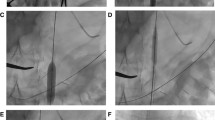Abstract
The purpose of this study was to determine the performance of two balloon-retention-type gastrostomy tubes when the balloons are inflated with two types of contrast materials at different concentrations. Two commonly used balloon-retention-type tubes (MIC and Tri-Funnel) were inflated to the manufacturer’s recommended volumes (4 and 20 cm3, respectively) with normal saline or normal saline plus different concentrations of contrast material. Five tubes of each brand were inflated with normal saline and 0%, 25%, 50%, 75%, and 100% contrast material dilutions, using either nonionic hyperosmolar contrast, or nonionic iso-osmolar contrast. The tubes were submerged in a glass basin containing a solution with a pH of 4. Every week the tubes were visually inspected to determine the integrity of the balloons, and the diameter of the balloons was measured with a caliper. The tests were repeated every week for a total of 12 weeks. The MIC balloons deflated slightly faster over time than the Tri-Funnel balloons. The Tri-Funnel balloons remained relatively stable over the study period for the different concentrations of contrast materials. The deflation rates of the MIC balloons were proportionally related to the concentration of saline and inversely related to the concentration of the contrast material. At high contrast material concentrations, solidification of the balloons was observed. In conclusion, this in vitro study confirms that the use of diluted amounts of nonionic contrast materials is safe for inflating the balloons of two types of balloon-retention feeding tubes. High concentrations of contrast could result in solidification of the balloons and should be avoided.







Similar content being viewed by others
References
de Baere T, Chapot R, Kuoch V et al (1999) Percutaneous gastrostomy with fluoroscopic guidance: single-center experience in 500 consecutive cancer patients. Radiology 210:651–654
Dewald CL, Hiette PO, Sewall LE, Fredenberg PG, Palestrant AM (1999) Percutaneous gastrostomy and gastrojejunostomy with gastropexy: experience in 701 procedures. Radiology 211:651–656
Lee MJ (1997) PEG–Is the E necessary? A comparison of percutaneous and endoscopic gastrostomy. Clin Radiol 52:77
Wollman B, D’Agostino HB, Walus-Wigle JR, Easter DW, Beale A (1995) Radiologic, endoscopic and surgical gastrostomy: an institutional evaluation and meta-analysis of the literature. Radiology 197:699–704
Hoffer EK, Cosgrove JM, Levin DQ, Herskowitz MM, Sclafani SJ (1999) Radiologic gastrojejunostomy and percutaneous endoscopic gastrostomy: a prospective randomized comparison. J Vasc Interv Radiol 10:413–420
Funaki B, Peirce R, Lorenz J et al (2001) Comparison of balloon and mushroom retained large bore gastrostomy catheters. AJR 177:359–362
Giuliano AW, Yoon HC, Lomis NN, Miller FJ (2000) Fluoroscopically guided percutaneous placement of large-bore gastrostomy and gastrojejunostomy tubes: review of 109 cases. J Vasc Interv Radiol 11:239–246
Dinkel HP, Beer KT, Zbären P, Triller J (2002) Establishing radiological percutaneous gastrostomy with balloon-retained tubes as an alternative to endoscopic and surgical gastrostomy in patients with tumours of the head and neck or oesophagus. Br J Radiol 75:371–377
Lyon SM, Haslam PJ, Duke DM, McGrath FP, Lee MJ (2003) De novo placement of button gastrostomy catheters in an adult population: experience in 53 patients. J Vasc Interv Radiol 14:1283–1289
Author information
Authors and Affiliations
Corresponding author
Rights and permissions
About this article
Cite this article
Lopera, J.E., Alvarez, A., Trimmer, C. et al. Stability of Balloon-Retention Gastrostomy Tubes with Different Concentrations of Contrast Material: In Vitro Study. Cardiovasc Intervent Radiol 32, 127–131 (2009). https://doi.org/10.1007/s00270-008-9355-z
Received:
Revised:
Accepted:
Published:
Issue Date:
DOI: https://doi.org/10.1007/s00270-008-9355-z



